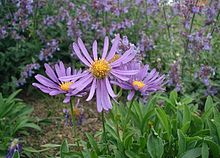Aster (genus)
| Aster | |
|---|---|

| |
| Aster amellus | |
| Scientific classification | |
| Kingdom: | Plantae |
| Clade: | Tracheophytes |
| Clade: | Angiosperms |
| Clade: | Eudicots |
| Clade: | Asterids |
| Order: | Asterales |
| Family: | Asteraceae |
| Tribe: | Astereae |
| Genus: | Aster L., 1753 |
| Type species | |
| Aster amellus | |
| Synonyms[2] | |
| |
Aster is a genus of perennial flowering plants in the family Asteraceae. Its circumscription has been narrowed, and it now encompasses around 170 species, all but one of which are restricted to Eurasia; many species formerly in Aster are now in other genera of the tribe Astereae. Aster amellus is the type species of the genus and the family Asteraceae.[1]
The name Aster comes from the Ancient Greek word ἀστήρ (astḗr), meaning "star", referring to the shape of the flower head. Many species and a variety of hybrids and varieties are popular as garden plants because of their attractive and colourful flowers. 'Aster' species are used as food plants by the larvae of a number of Lepidoptera species—see list of Lepidoptera that feed on Aster. Asters can grow in all hardiness zones.
Circumscription[]

The genus Aster once contained nearly 600 species in Eurasia and North America, but after morphologic and molecular research on the genus during the 1990s, it was decided that the North American species are better treated in a series of other related genera. After this split there are roughly 180 species within the genus, all but one being confined to Eurasia.[3]
The New World species have now been reclassified in the genera Almutaster, Canadanthus, Doellingeria, Eucephalus, Eurybia, Ionactis, Oligoneuron, Oreostemma, Sericocarpus and Symphyotrichum, though all are treated within the same tribe, Astereae. The "China aster" is in the related genus Callistephus. Regardless of the taxonomic change, most are still widely referred to as "asters", or "Michaelmas daisies", because of their typical blooming period.
Species[]
This section needs additional citations for verification. (February 2021) |

In the United Kingdom, there are no native members of the genus, The species formerly known as Aster tripolium (sea aster) is now Tripolium pannonicum. The species formerly known as Aster linosyris (goldilocks) is now Galatella linosyris. Many species and a variety of hybrids and varieties are popular as garden plants because of their beautiful, attractive and colourful flowers. Aster species are used as food plants by the larvae of a number of Lepidoptera species—see list of Lepidoptera that feed on Aster. Asters can grow in all hardiness zones.
Some species are:
- – rough-surface aster
- Aster alpinus – alpine aster
- Aster amellus – European Michaelmas daisy, Italian aster
- – beach-sand aster
- – highly-branch aster
- – Ulleungdo aster
- – Korean montane aster
- Aster hispidus – bristle-hair aster
- – perennial false aster
- – incised-leaf aster
- Aster lautureanus – connected aster, mountain aster
- Aster maackii – Maack's aster
- – magnus aster
- Aster neoelegans
- Aster spathulifolius – seashore spatulate aster
- Aster tataricus – Tatarian aster, Tatarinow's aster
- [4]
- Aster tongolensis
Hybrids and cultivars[]
Those marked agm have gained the Royal Horticultural Society's Award of Garden Merit.
- Aster × frikartii (A. amellus × A. thomsonii) Frikart's aster[5]
- 'Kylie' (A. novae-angliae 'Andenken an Alma Pötschke' × A. ericoides 'White Heather')[8]
- 'Ochtendgloren' agm[9] (A. pringlei hybrid)
- 'Photograph' agm[10]
In history[]
The Hungarian revolution of 31 October 1918, became known as the "Aster Revolution" due to protesters in Budapest wearing this flower.[11]
References[]
- ^ a b Elizabeth Pennissi (2001). "Linnaeus's last stand?". Science. 291 (5512): 2304–2307. doi:10.1126/science.291.5512.2304. PMID 11269295. S2CID 83724152.
- ^ "Aster L." Plants of the World Online. Board of Trustees of the Royal Botanic Gardens, Kew. 2021. Retrieved 17 September 2021.
- ^ Luc Brouillet, Theodore M. Barkley & John L. Strother. "Asteraceae Martinov tribe Astereae Cassini, J. Phys. Chim. Hist. Nat. Arts. 88: 195. 1819". Flora of North America. p. 3. in Flora of North America.
- ^ "Convergent Origin of the narrowly lanceolate leaf in the Genus Aster—with Special Reference to An Unexpected Discovery of A New Aster Species from East China". Novataxa. 2019-01-27. Retrieved 11 February 2019.
- ^ Floridata: Aster × frikartii
- ^ "RHS Plant Selector - Aster × frikartii 'Mönch'". Retrieved 15 July 2013.
- ^ "RHS Plant Selector - A. × frikartii 'Wunder von Stäfa'". Retrieved 15 July 2013.
- ^ Klein, Carol (2004-10-22). "Blazin' squad". Telegraph. Retrieved 15 July 2013.
- ^ "RHS Plant Selector - Aster 'Ochtendgloren'". Retrieved 15 July 2013.
- ^ "RHS Plant Selector - Aster 'Photograph'". Retrieved 15 July 2013.
- ^ Hajdu, Tibor (1990). "Revolution, Counterrevolution, Consolidation". In Peter F. Sugar (ed.). A History of Hungary ([New printing]. ed.). Bloomington: Indiana University Press. p. 297. ISBN 0253355788.
- Aster (genus)
- Asteraceae genera
- Garden plants
- Taxa named by Carl Linnaeus